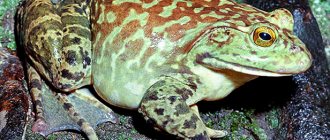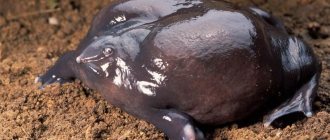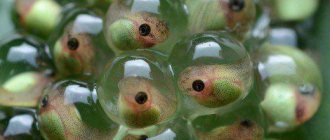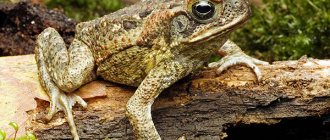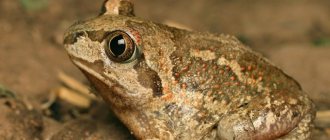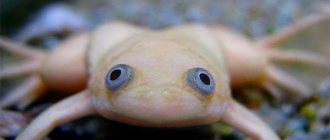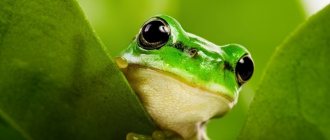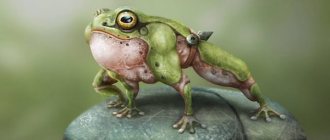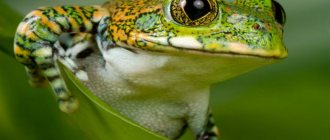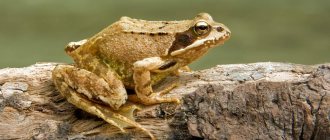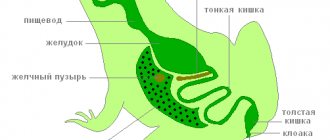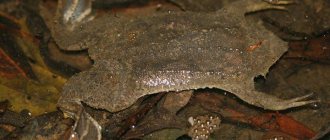Where do toads live?
Toad habitats
very diverse, of course, most species
live
in damp places - swamps, river backwaters, rain forests, but there are also those that settle in arid areas and even deserts.
In this case, toads
hide in crevices between stones and cracks in the soil.
Interesting materials:
How are deadlines determined in civil law? How does the organization pay maternity benefits? How is oil transported? How to be exempt from taxes? How to learn programming from scratch? How are payroll taxes calculated? How to report to the tax authorities for the sale of a car? How do individual entrepreneurs report to the simplified tax system? How to report for travel allowances? How do we relax during the October holidays?
LiveInternetLiveInternet
Quote from Marina_Ushakova's message
Read in full In your quotation book or community!
The Russian language never tires of giving us problems. Sometimes confusion arises with the genders of nouns. Let's take the animal world. An elephant has an elephant, a cat has a cat, but what do you call a male cuckoo? Kukun? Cuckoo? Cuckoo? Let's figure it out together.
Cuckoo: cuckoo, cuckoo or cuckoo?
Usually the names of animals of different sexes are formed using suffixes. A goose lives with a goose, a bear with a she-bear, and a siskin with (who do you think?) a siskin. There are exceptions. Kangaroo and muskrat are the best: these words can have both masculine and feminine gender, depending on whether we are talking about a female or a male.
There are also colloquial names. They are characteristic of exotic animals. They will understand you if you say “crocodile” or “dolphin,” but there is a more common option (discussed below).
You can come up with many options for the “husband” of the cuckoo. But alas, all of them will be incorrect from the point of view of the Russian language. So don't make up words that don't exist. It is better to follow the example of biologists, who call many animals the same, adding the word “female” or “male”. This means that the papa cuckoo is just a male cuckoo.
Using the same scheme, you can designate any animal whose name you doubt: a male chimpanzee, a female crocodile, etc.
You can come up with many options for the “husband” of the cuckoo. But alas, all of them will be incorrect from the point of view of the Russian language. So don't make up words that don't exist. It is better to follow the example of biologists, who call many animals the same, adding the word “female” or “male”. This means that the papa cuckoo is just a male cuckoo.
Crow: raven or raven?
“What is incomprehensible here? Of course, a male crow is a raven!” - many will think... and they will be wrong. This is a very common misconception. In fact, a raven and a crow are different birds (albeit related), and the confusion occurred because their names are similar. Moreover, this is the case only in the Russian language. For example, in English a crow is “crow”, and a raven is “raven”.
Crows are large blue-black birds. They live alone, away from people, for example, in the forests.
Crows, on the contrary, live in flocks and are often found in cities. These are very smart birds. A captive crow can even be trained to repeat words like a parrot.
There is no special word for a male crow. Just as with the cuckoo, he should simply be called a male crow.
Horse: horse or stallion?
Mom is a horse, child is a foal, dad is a horse? But no! The word "horse" is the same as "horse". Only it is of Slavic origin, not Turkic. From the word “horse” the word “prince” was formed, which at first meant a person on a horse.
But a male horse is a stallion. Hence, in fact, the word “foal”. A castrated stallion is called a gelding.
Pig: pig or boar?
In the children's cartoon Peppa Pig, the father of the pig family is called Daddy Pig. This is how misconceptions are formed from childhood. Because a male pig is actually called a boar. This is a funny word derived from the sound these animals make. A castrated boar is called a hog.
Vixen: fox or fox?
For foxes, things are not so simple. Firstly, from a zoological point of view, it is correct to call a female a fox. Fox is a colloquial word. Remember, even Krylov’s famous fable is called “The Crow and the Fox.”
Also colloquially, a male fox is called a fox. But this is also wrong! The official zoological term is foxtail.
And even the names of their cubs have nuances. They are really fox cubs, as we are accustomed to from childhood, but they can also be called puppies, because foxes belong to the Canidae family.
Zebra: zebra or zebras?
A lot of options immediately come to mind. Zebra? Zebrun? Or maybe even a zebra? It is important to remember here that zebras are relatives of horses. This means that a zebra’s “husband” can be called a stallion, just like in domestic horses.
Roe deer: roe deer or roe deer?
This small and very cute deer with small antlers is actually a close relative of the domestic goat. Initially, it was called a roe, but over time the word was transformed.
From a biological perspective, a male roe deer is simply a male roe deer. But the Altaians have their own word for it - “kuran”. August in Altai is called the “month of the roe deer” - “kuran-ai”. It is at this time that males compete for the female's attention.
Female and male animals sometimes have non-obvious names. These questions can confuse not only a child, but also an adult. In colloquial speech, of course, invented words are allowed, but from the point of view of the Russian language everything is clear. And now you are unlikely to make a mistake.
from here
Frogs: description
The frog family is distinguished by the fact that they do not have a clearly defined neck, so it seems that the head is literally one piece with a wide body. These animals also lack a tail, which is reflected in the very name of the order and is its characteristic difference. Frogs have simply unique vision, and they can control their living space within 360 degrees.
Appearance
Frogs have a relatively large head, flat in shape, along the edges of which there are bulging eyes. These animals, in comparison with some other representatives of the order, have 2 pairs of eyelids - lower and upper. Hidden under the lower eyelid is the nictitating membrane, which is also called the “third eyelid.” In the back of the eyes there is the so-called eardrum, which consists of an area covered with thin skin. Above the relatively large mouth you can see two nostrils armed with special valves. The frog's mouth is armed with fairly small teeth.
The frog's front legs are armed with four very short fingers, compared to the hind legs, which are much better developed and end with five fingers, between which there is a special membrane of skin, which allows the frog to feel great in the water element. Frogs' toes do not have claws, which is also considered a characteristic feature of the family. At the back of the body is the so-called cloaca, which is the only outlet for processed food components. The frog's body is covered with bare skin, covered with a layer of special mucus, which is secreted by a large number of subcutaneous glands of the frog.
Interesting moment! The European frog does not grow more than 10 centimeters in length, while the African goliath frog is considered the largest representative of the family, growing up to half a meter in length and gaining weight of several kilograms.
As a rule, the size of frogs depends on their species, although generally their size ranges from 0.8 to 32 centimeters. The color of frogs is also so diverse, which are often distinguished by the rather variegated coloring of their bodies. Often the body color of these animals is associated with their natural habitat conditions, which allows them to easily camouflage among various vegetation, grasses, etc.
Often, the bright color of an animal is evidence of their toxicity, while toxic substances are produced by special glands located on the animal’s skin. These substances can be very dangerous not only for animals, but also for humans. Some species are able to imitate the “war” colors of poisonous frogs to protect themselves from natural enemies.
Coitus - amplexus
Types of amplexus
Frogs lay eggs like fish, since the eggs (eggs) and embryos lack adaptations for development on land (anamnia). Various species of amphibians lay eggs in surprising places:
- into burrows whose slopes descend into the water. When a tadpole hatches, it rolls into the water, where its further development takes place;
- the female forms nests or lumps with mucus collected from her skin, then attaches the nest to the leaves that hang over the pond;
- some wrap each egg in a separate leaf of wood or reed hanging over the water;
- the female of the species Hylambates brevirostris generally carries eggs in her mouth . Males of the Darwinian rhinoderma species have special pouches in the throat, where they carry the eggs laid by the female;
- in arid areas, narrow-mouthed frogs live, which lay eggs in damp soil, where the tadpole then develops, and the formed amphibian crawls onto land;
- females of the genus pipa carry the eggs on themselves. After fertilization of the eggs, the male presses them with his abdomen into the back of the female, laying the eggs in rows. Eggs that stick to plants or to the bottom of a reservoir cannot develop and die. They survive only on the female's back. A couple of hours after laying, a porous gray mass forms on the female’s back, into which the eggs are buried, then the female molts;
- some types of females form ring shafts from their own mucus;
- in some species of frogs, a so-called brood pouch is formed in the folds of skin on the back, where the amphibian carries eggs;
- Some Australian species of frogs carry eggs and tadpoles in their stomachs. During the period of gestation in the stomach, the function of producing gastric juice is turned off with the help of prostaglandin.
During the entire period of gestation of the tadpoles, which lasts two months, the frog does not eat anything, but remains active.
During this period, she uses only internal reserves of glycogen and fat, which are stored in her liver. After the gestation process, the frog's liver decreases three times in size and there is no belly fat left under the skin. Interesting: Why is the fox cunning and red?
After laying eggs, most females leave their clutch, as well as spawning waters, and go to their usual habitats.
The females usually surround the eggs with a large layer of gelatinous substance . The egg shell plays a big role, since the egg is protected from drying out, from damage, and most importantly, it protects it from being eaten by predators.
After laying, after some time, the shell of the eggs swells and forms into a transparent gelatinous layer, inside of which the egg is visible. The upper half of the egg is dark, and the lower half, on the contrary, is light. The dark part heats up more, as it uses the sun's rays more efficiently. In many species of amphibians, lumps of eggs float to the surface of a reservoir, where the water is much warmer.
Low water temperature delays the development of the embryo. If the weather is warm, the egg divides many times and forms into a multicellular embryo. Two weeks later, a tadpole emerges from the egg - a frog larva.
Toad - what do we know about it?
Frogs, toads and newts usually do not evoke sympathy in humans. These cold, slippery amphibians, or amphibians, are often destroyed only because of hostile attitudes towards them, without suspecting that they are beneficial while living in the garden. Adult amphibians feed on various invertebrate animals, often exterminating those that birds do not even come close to - those that are brightly and contrastingly colored, with a pungent or unpleasant odor.
Abroad, toads have long been used specifically to control pests of garden crops. Gardeners in England, Holland, and Hungary imported them from other countries and released them into gardens and greenhouses. In the mid-30s, 150 specimens of the aga toad were delivered from the Antilles to the Hawaiian Islands. She was bred and released on a sugar cane plantation, which gave very good results. In our country, such experiments were carried out only by young people at their school sites.
Reed toad
During the breeding season, all amphibians accumulate in large numbers in water bodies. It's very interesting to watch them. Some, like tritons, organize mating games, others - concerts. Males of “singing” tailless amphibians have special vocal sacs - resonators that amplify the sound produced. Everyone has heard the loud concerts of green frogs, but the gentle trills of the green toad are familiar only to specialists and nature lovers. Quite recently, in some areas of Moscow, one could still see and hear green toads and the quiet “hooting” of fire-bellied toads—small tailless amphibians with a brightly spotted belly. Now there are almost no such places left.
Toads are very widespread around the globe, there are more than 250 species. On the territory of our country there are 6: common gray and Far Eastern , green , Danatin , reed and Mongolian toads . These species can be found in European Russia, the Caucasus, Kazakhstan and Central Asia, Siberia and the Far East.
The most common for us are the common gray and green toads. The Mongolian inhabits Transbaikalia and the Far East, and the reed is found in the Baltic states, Belarus and Western Ukraine.
Mongolian toad
The reed toad is similar in appearance to the green toad, but more graceful, with a thin stripe along the back. The reed toad is the only species of this genus of our fauna included in the Red Book of Russia. This toad is being protected; they are trying to breed it in the laboratory so that the grown toads can subsequently be released into the wild, since in many places it has practically disappeared.
The common gray toad , which is more cold-loving than the green one and larger, is also widespread in our country It inhabits forest and steppe zones, rising into the mountains up to 3000 m above sea level. The largest gray toads are found in lowland, foothill and mountain forests of the Caucasus, often settling in gardens and vegetable gardens near humans. Caucasian toads are bright ocher in color, with large parotids, golden-orange irises of the eyes and impressive sizes - up to 150-200 mm!
Far Eastern toad
On occasion, they can even swallow newborns and small rodents.
The Far Eastern gray toad is no less attractive .
Toads differ from frogs in their dense build, shorter limbs and thick tuberous skin, on which single poisonous glands are scattered, and behind the eyes there are large parotid glands - parotids. They secrete a poisonous secretion - a kind of defense. For humans, these secretions do not pose a danger, but in animals, when they come into contact with the mucous membrane of the mouth, they cause burning and vomiting.
Common toad. ©
How do toads live and why do we rarely see them?
Firstly, in temperate latitudes, all amphibians and reptiles that have an unstable body temperature spend the autumn-winter period in hibernation. Toads overwinter in rodent burrows, under stones, and can burrow into loose soil to a depth of 10-12 cm. The green toad, which inhabits desert areas, sleeps even in the hottest time of the year, sometimes not appearing on the surface until spring.
Secondly, in the summer, toads switch to a nocturnal lifestyle, hunting and replenishing water supplies only after dark. They can be seen under street lamps, where many insects gather. Having noticed the prey, the toad heads towards it, but does not jump like a frog, but “walks”. The green toad's diet includes snails, millipedes, various insects, butterfly larvae and caterpillars. In the autumn, on the outskirts of southern cities, you can see many toads moving to their wintering places, and in the spring - again to their breeding places. At this time, many animals die on highways, so in some countries warning signs are placed on the roads and special tunnels are made to allow animals to avoid dangerous places.
What is the name of a male tit?
Names of baby animals
| Parents | Cub (child) singular | |
| Father ( male ) | Mother (female) | |
| Male tit | Tit | Tit chick , colloquially found as titmouse |
| Woodpecker | Woodpecker female | Woodpecker chick, woodpecker calf is used in zoology |
| Boar | Kabanikha | Little boar |
In which country do they eat frogs?
These days, deep-fried frog
served in many Odessa restaurants as a popular Odessa and Bessarabian specialty.
Frogs
are also consumed in many other regions: the Caribbean, Portugal, northwestern Greece, Italy, Spain, and the American South (Cajun cuisine).
Interesting materials:
Is it possible to lay heated floors under parquet boards? Is it possible to inject Cavinton intravenously? Can smoked mackerel be stored in the freezer? Is it possible to feed a cat millet porridge? Is it possible to feed lard to pigs? Is it possible to feed pigs dry food? Can a cat eat canned peas? Can a cat eat cauliflower? Is it possible to paint OSB with facade paint? Is it possible to paint OSB paint?
